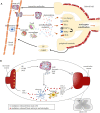Involvement of Mast Cells in the Pathophysiology of Pain
- PMID: 34177465
- PMCID: PMC8222580
- DOI: 10.3389/fncel.2021.665066
Involvement of Mast Cells in the Pathophysiology of Pain
Abstract
Mast cells (MCs) are immune cells and are widely distributed throughout the body. MCs are not only classically viewed as effector cells of some allergic diseases but also participate in host defense, innate and acquired immunity, homeostatic responses, and immunoregulation. Mounting evidence indicates that activation of MCs releasing numerous vasoactive and inflammatory mediators has effects on the nervous system and has been involved in different pain conditions. Here, we review the latest advances made about the implication of MCs in pain. Possible cellular and molecular mechanisms regarding the crosstalk between MC and the nervous system in the initiation and maintenance of pain are also discussed.
Keywords: hyperalgesia; immunoregulation; inflammation; mast cells; pain.
Copyright © 2021 Mai, Liu, Huang, He and Fan.
Conflict of interest statement
The authors declare that the research was conducted in the absence of any commercial or financial relationships that could be construed as a potential conflict of interest.
Figures


Similar articles
-
Mast cell mediators: their differential release and the secretory pathways involved.Front Immunol. 2014 Nov 14;5:569. doi: 10.3389/fimmu.2014.00569. eCollection 2014. Front Immunol. 2014. PMID: 25452755 Free PMC article. Review.
-
Advances in mast cell biology: new understanding of heterogeneity and function.Mucosal Immunol. 2010 Mar;3(2):111-28. doi: 10.1038/mi.2009.136. Epub 2009 Dec 30. Mucosal Immunol. 2010. PMID: 20043008 Review.
-
Mast Cell-Mediated Orchestration of the Immune Responses in Human Allergic Asthma: Current Insights.Clin Rev Allergy Immunol. 2019 Apr;56(2):234-247. doi: 10.1007/s12016-018-8720-1. Clin Rev Allergy Immunol. 2019. PMID: 30506113 Review.
-
Mast Cells in the Skin: Defenders of Integrity or Offenders in Inflammation?Int J Mol Sci. 2021 Apr 27;22(9):4589. doi: 10.3390/ijms22094589. Int J Mol Sci. 2021. PMID: 33925601 Free PMC article. Review.
-
Role and relevance of mast cells in fungal infections.Front Immunol. 2012 Jun 13;3:146. doi: 10.3389/fimmu.2012.00146. eCollection 2012. Front Immunol. 2012. PMID: 22707950 Free PMC article.
Cited by
-
Pain Biomarkers in Fibromyalgia Syndrome: Current Understanding and Future Directions.Int J Mol Sci. 2023 Jun 21;24(13):10443. doi: 10.3390/ijms241310443. Int J Mol Sci. 2023. PMID: 37445618 Free PMC article. Review.
-
Systemic pain relief after omalizumab injection in patient with hypermobile Ehlers-Danlos syndrome: A case report.Clin Case Rep. 2024 Jan 12;12(1):e8431. doi: 10.1002/ccr3.8431. eCollection 2024 Jan. Clin Case Rep. 2024. PMID: 38223517 Free PMC article.
-
Rutin ameliorates inflammatory pain by inhibiting P2X7 receptor in mast cells.J Physiol Biochem. 2023 May;79(2):287-295. doi: 10.1007/s13105-022-00938-w. Epub 2022 Dec 13. J Physiol Biochem. 2023. PMID: 36512286
-
Brain-body physiology: Local, reflex, and central communication.Cell. 2024 Oct 17;187(21):5877-5890. doi: 10.1016/j.cell.2024.08.050. Cell. 2024. PMID: 39423806 Free PMC article. Review.
-
Mast Cells and Acupuncture Analgesia.Cells. 2022 Mar 2;11(5):860. doi: 10.3390/cells11050860. Cells. 2022. PMID: 35269483 Free PMC article. Review.
References
-
- Ammendola M., Sacco R., Sammarco G., Donato G., Zuccalà V., Romano R., et al. . (2013). Mast cells positive to tryptase and c-kit receptor expressing cells correlates with angiogenesis in gastric cancer patients surgically treated. Gastroenterol. Res. Pract. 2013:703163. 10.1155/2013/703163 - DOI - PMC - PubMed
LinkOut - more resources
Full Text Sources

